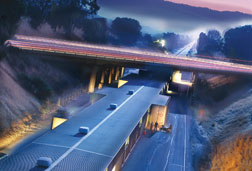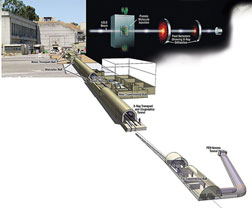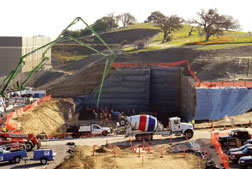
Standford Linac Center |

Standford Linac Center Researchers at the Stanford Linear Accelerator have won four Nobel Prizes.
|
Science’s most brilliant breakthroughs today happen on a scale so small that researchers can study them only with light wavelengths short enough to catch individual atoms in their beam. The international race to build light sources capable of such illumination has begun, and the Linear Accelerator Center operated by Stanford University is in position to reach the finish first.
The Stanford Linear Accelerator Center (SLAC), Menlo Park, Calif., has operated on the frontier of high-energy physics research since 1962. The linear accelerator, or Linac, has been instrumental in discovering evidence of quarks and other subatomic building blocks of matter. Four Nobel Prizes have rewarded researchers’ achievements. Now, SLAC is preparing to refocus on the growing fields of photon science and particle-and-particle astrophysics.
A key tool will be the Linac Coherent Light Source (LCLS), the world’s first X-ray free-electron laser. It will operate like a strobe light for nanoscale photography using an intense, tightly focused beam of X-rays, infrared and ultraviolet radiation 10 billion times brighter than any to date. The fast, bright X-ray pulses will illuminate subatomic dynamics that are invisible using light with longer wavelengths.
| + click to enlarge |
 Standford Linac Center New construction ties in at headwall via Beam Transport Hall, then goes into tunnel. |
“Before the LCLS, it would take about one second of exposure to X-rays to get a picture or measurement. During that time, the atoms have moved, jiggled or maybe run away, so the pictures are blurred,” says John N. Galayda, LCLS project director. He compares the effect to photographing a hummingbird’s flight with a 1-second exposure. The LCLS X-rays will be “so intense that we can do stop-action photography of atoms as they move,” he says. The LCLS will permit scientists to understand and manipulate matter at the atomic level.
LCLS construction began last fall and is scheduled for completion by June 2008 at a total project cost of $379 million, including line equipment and management, design and construction-related costs, all funded by the U.S Dept. of Energy. It will add a half-mile enclosure and tunnel to the 2-mile-long Linac.
| + click to enlarge |
 Standford Linac Center Ultrafast pulses take images of injected molecules. Multiple diffraction patterns yield 3-D images of molecule structures. |
The LCLS will generate the electron beams in the last kilometer of the Linac, bending and focusing them with magnets. The quadrupole undulator, a series of 33 magnets, will make the electrons oscillate right and left, emitting X-radiation and continually bathing them in their own X-rays so they travel in a perfectly straight line, says Galayda.
The LCLS will extend the Linac’s beam on a perfectly straight, flat line running as deep as 110 ft under the Palo Alto Hills. It will connect to the Linac via the 745-ft-long Beam Transport Hall (BTH), crossing the existing Research Yard, a largely open area dotted with buildings. Penetrating a hillside, it will enter the 565-ft-long Undulator Hall tunnel and connect to the 131-ft-long Electron Beam Dump. The beam dump and the 116-ft-long Front End Enclosure both will be built with cut-and-cover methods and connect to the Near Experimental Hall (NEH). This 25,000-sq-ft, two-level concrete structure, to be covered after construction, will house experimental hutches, prep, shop space and a large bay.
From the NEH, the 660-ft-long X-Ray Transport and Diagnostics Tunnel will run to the Far Experimental Hall (FEH), a two-level mined cavern. An access tunnel, on which construction started in early March, is being mined at an acute angle toward the FEH. The bulk of the LCLS—the Undulator Hall and all facilities beyond the Near Experimental Hall—will be completely underground, constructed by tunneling.
On March 29, Insituform Technologies Inc., Chesterfield, Mo., announced its intention to close its tunneling operations and seek a buyer for subsidiary Affholder Inc., the LCLS tunnel subcontractor. With most tunneling still ahead, Galayda is watching the situation closely.
“I would love to know what the most likely disposition of Affholder might be,” he says. “Simple takeover, I hope, but I don’t really know. I recognize that, in situations like this, one might worry that Affholder employees might start looking for jobs [that have] less uncertainty.”
Announcing the decision, Insituform President and CEO Thomas Rooney Jr. said, “We intend to fulfill all contractual obligations and responsibilities associated with our customers, partners and vendors as we wind down this business.”

Standford Linac Center The Near Experimental Hall is one of three structures in the middle of the beam line being built from the surface instead of tunneled.
|
Long Time Coming
The status of Affholder was only the latest bump on what has been a long, hard road for the project. Since 1992, it has run the gauntlet of approvals required for costly Energy Dept. research projects. Years of research and development preceded the 2001 approval of LCLS construction. Jacobs Engineering, Pasadena, Calif., began design in 2004, with a target budget for civil construction of $75 million. Turner Construction, New York City, came on board in late 2005. As CM for-fee initially, Turner sought bids from subcontractors that would work under contracts held by Turner.
Design concepts over the years evolved to get maximum yield from the available funds. By 2005, Galayda considered the design locked, and value engineering began. He thought the design should be close to the budget. “We got engineer’s estimates from Jacobs and an independent estimator and market forecasts from Jacobs,” he says. But the bids were surprisingly high.
“Right now, it’s a real busy environment in the Bay Area. It’s not a buyer’s market,” says Michael D. Owens, Turner project manager. “Between 2005 and 2006, there was a substantial market change,” Galayda adds. “We hit the peak of the cost of materials.”
A boom in area construction absorbed much of the labor and construction capacity for which the LCLS competes. And in 2006, the San Francisco Public Utilities Commission launched a $4-billion program to upgrade its water-supply...
